10 Best Carbon Mineralization Offsets (Complete 2024 List)
Impactful Ninja is reader-supported. When you buy through links on our site, we may earn an affiliate commission.
Learn more
Learn more
.
Hey fellow impactful ninja ? You may have noticed that Impactful Ninja is all about providing helpful information to make a positive impact on the world and society. And that we love to link back to where we found all the information for each of our posts. Most of these links are informational-based for you to check out their primary sources with one click. But some of these links are so-called "affiliate links" to products that we recommend. First and foremost, because we believe that they add value to you. For example, when we wrote a post about the environmental impact of long showers, we came across an EPA recommendation to use WaterSense showerheads. So we linked to where you can find them. Or, for many of our posts, we also link to our favorite books on that topic so that you can get a much more holistic overview than one single blog post could provide. And when there is an affiliate program for these products, we sign up for it. For example, as Amazon Associates, we earn from qualifying purchases. First, and most importantly, we still only recommend products that we believe add value for you. When you buy something through one of our affiliate links, we may earn a small commission - but at no additional costs to you. And when you buy something through a link that is not an affiliate link, we won’t receive any commission but we’ll still be happy to have helped you. When we find products that we believe add value to you and the seller has an affiliate program, we sign up for it. When you buy something through one of our affiliate links, we may earn a small commission (at no extra costs to you). And at this point in time, all money is reinvested in sharing the most helpful content with you. This includes all operating costs for running this site and the content creation itself. You may have noticed by the way Impactful Ninja is operated that money is not the driving factor behind it. It is a passion project of mine and I love to share helpful information with you to make a positive impact on the world and society. However, it's a project in that I invest a lot of time and also quite some money. Eventually, my dream is to one day turn this passion project into my full-time job and provide even more helpful information. But that's still a long time to go. Stay impactful,Affiliate Disclosure
Why do we add these product links?
What do these affiliate links mean for you?
What do these affiliate links mean for us?
What does this mean for me personally?
![]()
Carbon mineralization is the result of a chemical reaction between carbon dioxide (CO2) and certain types of rocks. It is a scalable solution capable of removing large amounts of CO2 from the atmosphere, which in turn can help mitigate climate change. So, we had to ask: what are the best carbon mineralization offsets?
The best carbon mineralization offsets are offered by Climeworks, Neustark, and greenSand which permanently store CO2 underground, in concrete, or in Olivine rocks, respectively. In addition, CarbonCure, CarbonBuilt, and Silicate all lock away CO2 in concrete.
Keep reading to learn more about the best carbon mineralization offsets, how these carbon offset projects work, and what their respective offsetting costs are. At the end of the article, we’ll also share with you how effective carbon mineralization offsets are, what their pros and cons are, and how these offsets can help mitigate climate change.
Here’s What All the Best Carbon Mineralization Offsets Have in Common
Carbon offsets are reductions in carbon emissions that are used to compensate for carbon emissions occurring elsewhere. They are measured in tons of CO2 equivalents and are bought and sold through international brokers, online retailers, and trading platforms on what is known as the global carbon offset market.
“Carbon offset: a way for a company or person to reduce the level of carbon dioxide for which they are responsible by paying money to a company that works to reduce the total amount produced in the world, for example by planting trees”
Oxford Dictionary
Carbon mineralization is a form of technological carbon removal, the process of eliminating carbon from the atmosphere. More specifically, it is the removal of carbon from the atmosphere by sequestering it in permanent reservoirs.
“Carbon Removal: the process of removing CO2 from the atmosphere”
The Intergovernmental Panel on Climate Change
Carbon mineralization, also referred to as enhanced weathering, refers to the process by which atmospheric CO2 reacts with silicate material and rocks rich in calcium and magnesium (e.g., basalt rocks).
“Carbon mineralization: the process by which carbon dioxide becomes a solid mineral, such as a carbonate. It is a chemical reaction that happens when certain rocks are exposed to carbon dioxide”
The United States Geological Survey
There are two main types of carbon mineralization:
- Injecting CO2 into underground rock formations
- Exposing CO2 to broken pieces of rock at the Earth’s surface
Underground, CO2 is injected into wells that lead to igneous or metamorphic rock formations. At the surface, CO2 is exposed to basalt rocks, ultramafic rocks, or mine tailings (mine waste). Both approaches permanently lock away atmospheric carbon for thousands of years.
These Are the Best Carbon Mineralization Offsets in 2024
Below are our favorite carbon mineralization offsets (you can click on their link to directly jump to their section in this article):
| Carbon Mineralization Offsets | Quick Facts |
| Climeworks | About: Carbon offset purchases support the practice of direct CO2 removal, where specialized machines remove CO2 directly from the air and store it in rock formations underground. Costs: $1.20 per 1kg of CO2 |
| Neustark | About: Neustark removes CO2 from the atmosphere and stores it in recycled concrete, and they cut new CO2 emissions by reducing the use of traditional cement. Costs: Costs are determined after initial contact. |
| greenSand | About: greenSand uses Olivine rocks, which trap CO2 when they come into contact with water. For every ton of CO2 purchased, greenSand spreads 1 ton of Olivine, which can in turn absorb and permanently store 1 ton of CO2. Costs: $82 per 1,000kg of CO2 |
| InPlanet | About: InPlanet accelerates the natural process of enhanced weathering by grinding and spreading silicate rocks on tropical soils. The silicate rocks capture and store carbon for thousands of years and help regenerate tropical soils by acting as a long-term fertilizer. Costs: Costs are determined after initial contact |
| CarbonCure | About: CarbonCure’s technology allows concrete producers to inject captured CO2 into fresh concrete during mixing. The CO2 then reacts with the concrete mix and is chemically converted into a mineral, where it is permanently stored for thousands of years. Costs: $165 per 1,000kg of CO2 |
| UNDO | About: UNDO accelerates the natural process of enhanced weathering by spreading crushed basalt rock on farmlands. The rock absorbs CO2 and locks it away in mineral form for thousands of years. Costs: $0.50 per 1kg of CO2 for individuals. Business carbon offsets are determined after initial contact. |
| Heirloom | About: Heirloom’s technology captures CO2 through an accelerated process of natural mineralization, whereby minerals absorb CO2 from the air. The CO2 is then injected underground and stored permanently. Costs: Costs are determined after initial contact |
| CarbonBuilt | About: Carbonbuilt takes CO2 generated by industrial processes and transforms it into precast concrete. Costs: One-time or monthly subscription options for $200 per ton of CO2 + processing fees |
| Arca | About: Arca is a startup speeding up the natural process of weathering. They partner with mines and transform mine tailings into giant carbon sinks capable of extracting and permanently storing large amounts of CO2. Costs: Costs will be determined after initial contact |
| Silicate | About: Silicate is a startup leveraging the carbon removal potential of surplus concrete. They grind surplus concrete to dust so that it can be spread on farmlands. The crushed concrete reacts with carbonic acid in the soil to remove CO2 from the air. Costs: Costs will be determined after initial contact |
Climeworks: The Leader in Direct CO2 Removal
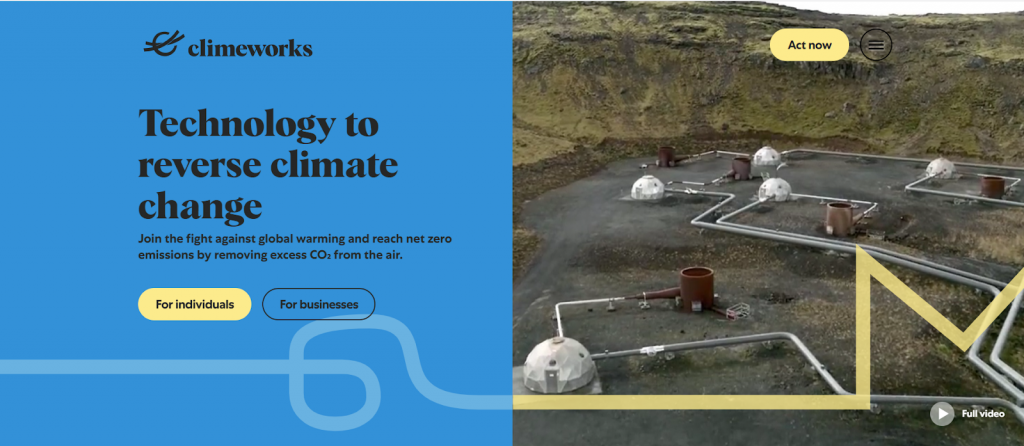
Climeworks is a Swiss direct air capture company founded in 2009 by engineering university students Jan and Christoph, who were both shocked at the melting glaciers in the Swiss Alps. Today, their mission is to inspire one billion people to remove CO2 from the air and reverse climate change.
“Let’s reverse climate change”
Climeworks
Project overview: Climeworks’ process can be divided into two parts: carbon capture and carbon storage. Climeworks has specialized machines that first capture CO2 from the air. They then partnered with Icelandic company Carbfix to turn the captured CO2 into stone in less than two years. Carbfix dissolves the captured CO2 in water and injects it underground where it reacts with basalt rock to form solid minerals via natural processes. To date, they have injected over 70,000 tons of CO2 at their Icelandic site.
Carbon offset effectiveness: Climeworks offsets are permanent, measurable, and effective. Carbfix’s process is based on scientific research and has been proven successful at an industrial scale.
Carbon offset costs: Climeworks offers monthly, one-off, or gift carbon purchase options at a cost of $1.20 per 1kg of CO2 removed.
How to get your carbon offsets: You can get your carbon offsets directly from Climework’s webshop, where you can also select how much CO2 you want to remove along with your preferred frequency (monthly, one-off, or gift).
Neustark: Locking Away CO2 in Concrete
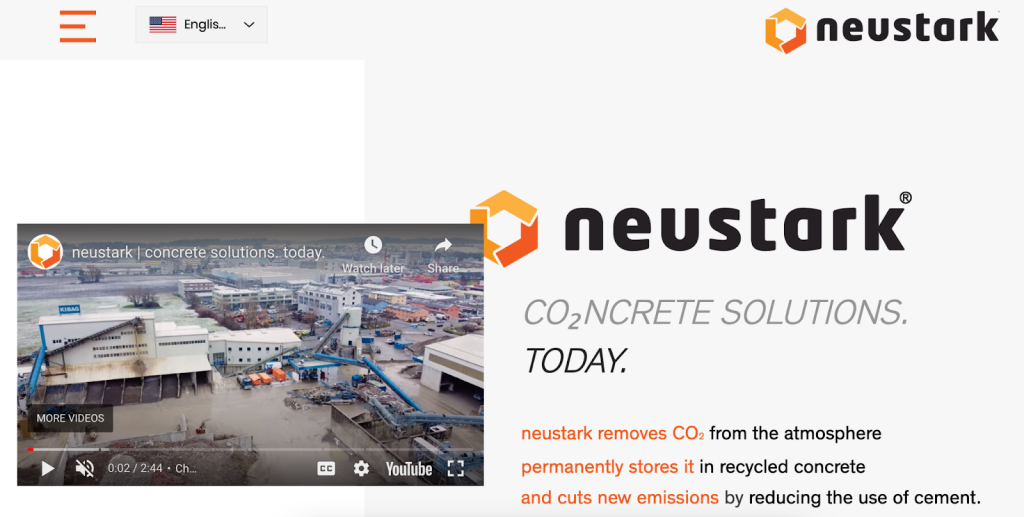
Neustark was founded in 2019 by Johannes Tiefenthaler and Valentin Gutknecht on the shared vision of a solution for the utilization and storage of CO2. Today they have developed technology that produces one of the most climate-friendly concrete. Their mission is to reduce the global construction industry’s carbon footprint by 1 billion tons of CO2 per year by 2050.
“Co₂ncrete Solutions. Today.”
Neustark
Project overview: Neustark removes CO2 from the atmosphere and permanently stores it in recycled concrete via the process of mineralization, what they call their ‘Carbon Dioxide Removal (CDR) service’. Approximately 10kg of CO2 are stored per cubic meter of concrete, and up to 20kg of CO2 emissions are avoided in the concrete production process. This results in a carbon removal efficiency of 95%.
Carbon offset effectiveness: Neustark’s carbon credits are permanent, safe, and only issued for net carbon removal. Their process is also credited by the Gold Standard.
Carbon offset costs: Costs are determined after initial contact.
How to get your carbon offsets: You can contact a Neustark representative to get your carbon offsets.
greenSand: Olivine – The Great CO2 Cleaner

greenSand was founded in 2009 by Eddy Wijnker after he realized that Olivine, a mineral, had the potential to clean up CO2. Today, they offer carbon offsets for individuals and businesses and have developed products of olivine-rich rocks that can replace current sand and stone applications. Their mission is to permanently clean up extra CO2 to bring balance back into the Earth’s CO2 cycle.
“We save the earth with stones and sand, will you help?”
greenSand
Project overview: greenSand uses Olivine rocks, which trap CO2 when they come into contact with water. The carbon stored in Olivine rocks is stored permanently, and it is only released if the temperature exceeds 1,600 degrees. For every ton of CO2 purchased, greenSand spreads 1 ton of Olivine, which can in turn absorb 1 ton of CO2.
Carbon offset effectiveness: greenSand is Open Natural Carbon Removal Accounting (ONCRA) certified. ONCRA is a framework for measuring the removal and storage of CO2 via nature-based solutions.
Carbon offset costs: greenSand’s offsets cost $82 per 1,000kg of CO2 offset.
How to get your carbon offsets: You can visit greenSand’s website to get your carbon offsets.
InPlanet: Enhanced Weathering of Silicate Rocks
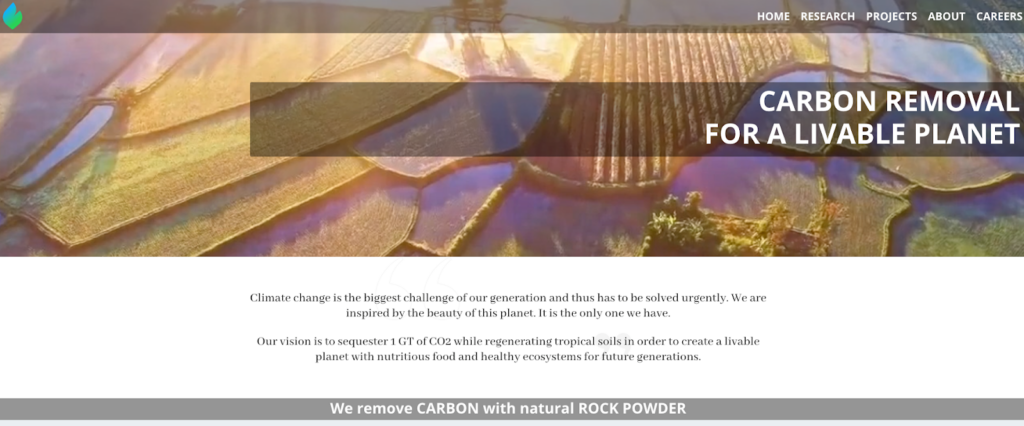
InPlanet was founded in 2022 by Felix Harteneck and Niklas Kluger to remove CO2 and regenerate tropical soils to create a healthy planet for future generations. Today, their mission is to help farmers replace chemicals with natural rock powders from local mines.
“Carbon removal for a liveable planet”
InPlanet
Project overview: InPlanet accelerates the natural process of enhanced weathering by grinding and spreading silicate rocks on tropical soils. The silicate rocks capture and store carbon for thousands of years and help regenerate tropical soils by acting as a long-term fertilizer. InPlanet currently focuses their efforts in Brazil, where the mineral-depleted soils and overall climate are conducive to fast and effective weathering. In the future, they plan to expand to other tropical markets.
Carbon offset effectiveness: InPlanet has partnered with Carbonfuture to join their Catalyst program, which provides carbon removal companies with monitoring, reporting, and verification.
They have also partnered with Cloverly, a leader in certified carbon offsets.
Carbon offset costs: Costs are determined after initial contact.
How to get your carbon offsets: You can visit InPlanet’s website to contact a representative and get your carbon offsets.
CarbonCure: CO2 Mineralization in Concrete
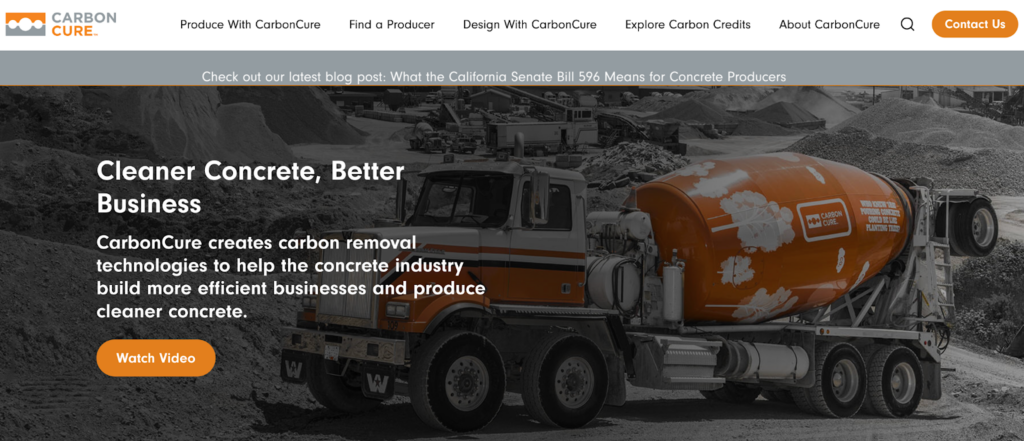
CarbonCure was founded in 2012 by Rob Niven to help decarbonize the concrete industry, which is responsible for roughly 7% of global CO2 emissions. Today, they permanently lock away CO2 in concrete on their mission to reduce carbon emissions by 500 million tonnes by 2030.
“Cleaner concrete, better business.”
CarbonCure
Project overview: CarbonCure’s technology targets embodied carbon, or the carbon emitted from manufacturing building materials and construction. Once retrofitted into concrete plants, the technology allows concrete producers to inject captured CO2 into fresh concrete during mixing. The CO2 then reacts with the concrete mix and is chemically converted into a mineral, where it is permanently stored for thousands of years.
Carbon offset effectiveness: CarbonCure’s carbon offsets are permanent, verifiable, and scalable. Their methodology for calculating CO2 removal is also verified by Verra, a leader in carbon offset standards.
Carbon offset costs: CarbonCure’s subscription plans cost $165 per 1,000kg of CO2 offset. You can also create a custom plan.
How to get your carbon offsets: You can visit CarbonCure’s website to get your carbon offsets.
UNDO: Enhanced Weathering of Basalt Rocks

UNDO, an offshoot of the Future Forest Company, was founded in 2020 by Jim Mann as a way to undo years of carbon emissions via enhanced weathering. Today, their mission is to become the first company to remove 1 million tons of CO2.
“Putting carbon in its place”
UNDO
Project overview: UNDO accelerates the natural process of enhanced weathering by spreading crushed basalt rock on farmlands, which increases the surface area of the rock and allows for immediate contact with the CO2 produced by plant roots and soil microbes. The basalt rock absorbs the carbon and locks it away in mineral form for thousands of years.
Carbon offset effectiveness: UNDO’s technology is permanent, rapid, and scalable with a 95% carbon efficiency.
Carbon offset costs: Individual carbon offsets are available as a monthly subscription that costs approximately $0.50 per 1kg of CO2. Business carbon offsets are determined after initial contact.
How to get your carbon offsets: You can visit UNDO’s business or individual carbon offset webpage to get your carbon offsets.
Heirloom: A Carbon Mineralization Solution
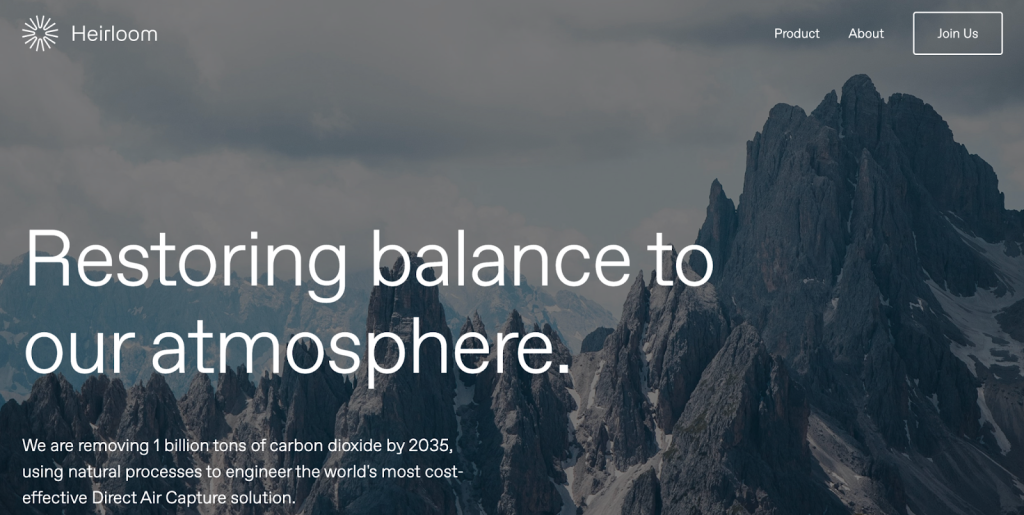
Heirloom was founded in 2020 by Noah McQueen and Shashank Samala on the belief that everyone on this planet deserves to thrive, and climate equity plays a big role in making that happen. Today, their mission is to remove one billion tons of CO2 from the air by 2035 by engineering the most cost-effective, scalable, direct air capture system.
“Restoring balance to our atmosphere”
Heirloom
Project overview: Heirloom’s carbon removal technology speeds up the process of natural mineralization, whereby minerals absorb CO2 from the air. They use limestone to capture CO2 directly from the atmosphere and then inject the CO2 underground or into concrete, where it is stored permanently.
Carbon offset effectiveness: Heirloom’s process permanently locks away CO2 in underground geological formations. The process is permanent, sustainable, and compact.
Carbon offset costs: Costs are determined after initial contact with the Heirloom team.
How to get your carbon offsets: You can contact an Heirloom representative to get your carbon offsets.
CarbonBuilt: Capturing CO2 in Concrete
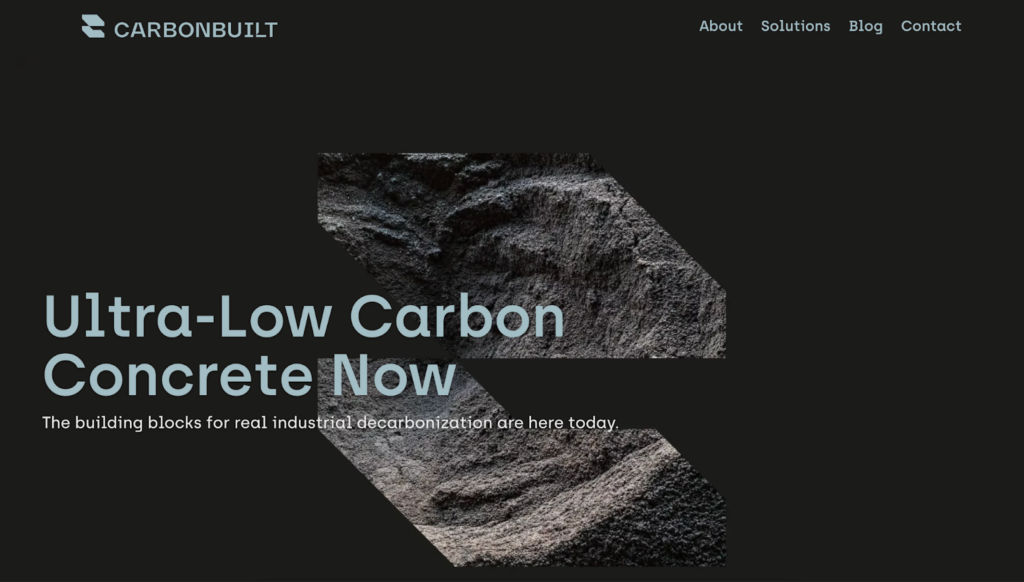
CarbonBuilt was founded in 2020 by Rahul Shendure and Gaurav Santas to create a world where global economic prosperity no longer threatens our climate. Today, their mission is to help concrete manufacturing drive greenhouse gas emissions reduction by using CO2 and other industrial wastes in a cost-effective manner.
“Carbon for good™”
CarbonBuilt
Project overview: CarbonBuilt takes CO2 generated by industrial processes and transforms it into precast concrete, where it remains locked away for 1,000+ years. The result is a 70 to 100+% reduction in the concrete’s carbon footprint. Their carbon credits are generated by removing cement and switching to materials produced with a lower carbon footprint (carbon avoidance) and by using natural mineralization to capture CO2 from industrial processes (carbon removal).
Carbon offset effectiveness: CarbonBuilt’s projects are measurable, permanent, and additional.
Carbon offset costs: Carbonbuilt offers a one-time or monthly subscription option for $200 per ton of CO2 + processing fees.
How to get your carbon offsets: You can visit CarbonBuilt’s website to get your carbon offsets.
Arca: Rocking CO2 For a Liveable Planet

Arca, formerly known as Carbin Minerals, was founded in 2021 by Greg Dipple, Peter Scheuermann, and Bethany Ladd to reduce mine waste and remove CO2 from the atmosphere. Today, they use mine waste and the natural process of weathering to permanently lock away CO2. Their mission is to provide durable carbon removal on a gigaton scale.
“From underground to rock star”
Arca
Project overview: Arca utilizes the natural process of weathering, where rocks absorb CO2 from the atmosphere and turn it into a mineral. Arca has developed research that speeds up the process into a matter of weeks or days, so by partnering with mines, they can transform mine tailings into giant carbon sinks capable of extracting and permanently storing large amounts of CO2 underground. Arca’s technology is still in the R&D phase, with their pilot project launching at an unnamed mining site. So far they have pre-sold $1 million in carbon credits to Shopify and Frontier.
Carbon offset effectiveness: Arca provides carbon offsets that are permanent and verifiable.
Carbon offset costs: Costs will be determined after initial contact.
How to get your carbon offsets: You can contact an Arca team representative to get your carbon offsets.
Silicate: Repurposing Concrete to Remove Carbon
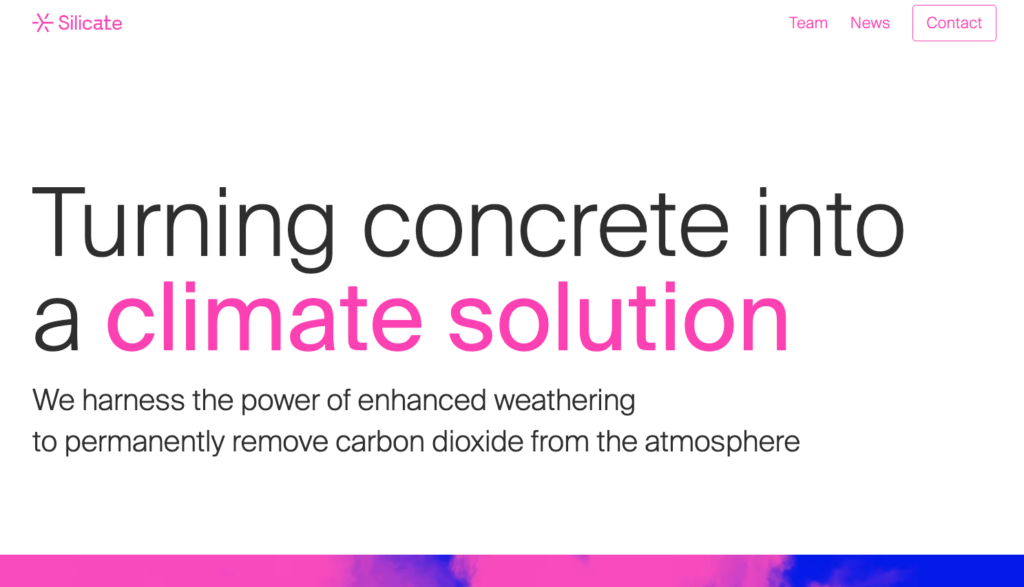
Silicate is an Irish start-up founded in 2021 by Maurice Bryson to reimagine agriculture’s role in responding to the climate crisis. Today, they repurpose concrete as part of their mission to permanently remove CO2 from the atmosphere via enhanced mineral weathering.
“Our process sees surplus concrete in a whole new light.”
Silicate
Project overview: Silicate is an Irish startup that is leveraging the carbon removal potential of surplus concrete. They grind surplus concrete to dust so that it can be spread on farmlands. The crushed concrete reacts with carbonic acid in the soil to remove CO2 from the air. Carbonate and calcite, the substances formed by this process, can store the captured CO2 for thousands of years.
Carbon offset effectiveness: Silicate has partnered with Carbonfuture to join its Catalyst program, which provides carbon removal companies with monitoring, reporting, and verification.
Carbon offset costs: Costs will be determined after initial contact.
How to get your carbon offsets: You can contact a Silicate team representative to get your carbon offsets.
How Effective and Efficient Are Carbon Mineralization Offsets
In terms of effectiveness, carbon mineralization offsets permanently and quickly remove CO2 from the atmosphere, keeping it locked away for thousands of years; however, they do not reduce your own carbon emissions, which can lead to greenwashing.
In terms of efficiency, carbon mineralization offsets have low rates of carbon re-emission; however, they are also relatively expensive and are not yet scaled to compensate for our global emissions.
Carbon mineralization offsets are effective at mitigating climate change because they:
- Permanently lock away CO2 for thousands of years with no long-term monitoring required
- Reduce emissions quicker than natural weathering processes and other nature-based solutions
However, carbon mineralization offsets can also lack effectiveness because they do not reduce your own carbon emissions, which can lead to greenwashing. This occurs when emissions are only offset and not reduced from the source, and the consumer is deceived into thinking they are offsetting their emissions but in reality, they are not.
Carbon mineralization offsets are efficient at reducing CO2 emissions because they are a permanent process with very low rates of CO2 re-emission. In addition, even if the rocks are broken, the carbon will remain trapped inside.
However, carbon mineralization offsets can also lack efficiency because they are one of the most expensive offsets out of all carbon removal methods, behind direct carbon capture (DCC). They are also not yet scaled to compensate for our global carbon emissions, although they could be scaled up to capture 2-4 billion tons of CO2 per year by 2050.
What Are The 5 Pros and 4 Cons of Carbon Mineralization Offsets
Carbon mineralization offsets are permanent, have a low rate of carbon re-emission, reduce emissions quickly, protect the biosphere, and can help offset emissions that cannot be reduced otherwise.
Carbon mineralization offsets are one of the most expensive methods of carbon removal, are not yet scaled to compensate for our global emissions, may induce seismic activity, and do not reduce your own emissions, which can lead to greenwashing.
What Are the 5 Pros of Carbon Mineralization Offsets
Carbon mineralization offsets have various pros that make them effective at sequestering carbon from our atmosphere.
| 5 Pros of Carbon Mineralization Offsets | Quick Facts |
| #1: Carbon mineralization offsets are permanent | Carbon mineralization offsets are a specific type of carbon offset that store carbon permanently in geological reservoirs. For example, Carbfix turns captured CO2 into stone, a process that locks away CO2 for thousands of years with no long-term monitoring required. |
| #2: Carbon mineralization offsets have a low rate of carbon re-emission | Because carbon mineralization is a permanent process, rates of carbon re-emission are very low. For example, greenSand Olivine rocks permanently store carbon and will only release that carbon back into the atmosphere if the temperature exceeds 1,600 degrees. |
| #3: Carbon mineralization offsets reduce CO2 emissions quickly | Enhanced weathering speeds up the natural carbon mineralization process by breaking down silicate rocks into tiny pieces, thereby skipping slow weathering processes. For example, Carbfix achieves 95% permanent carbon mineralization in under two years. |
| #4: Carbon mineralization offsets protect the biosphere | Removing carbon emissions from the atmosphere via carbon mineralization would lead to improved public health in terms of asthma, respiratory allergies, airway diseases, and lung cancer. It also promotes healthy ecosystems, which have been linked with cleaner air, water, and food. |
| #5: Carbon mineralization offsets can help offset carbon emissions that can’t be reduced otherwise | We already have governmental-level policies in place to reduce carbon emissions, but carbon mineralization offsets allow us to reduce emissions from activities where sustainable alternatives are not yet widely available. |
What Are the 4 Cons of Carbon Mineralization Offsets
Understanding the drawbacks of carbon mineralization offsets is important when implementing this strategy on a large scale in order to mitigate climate change.
| 4 Cons of Carbon Mineralization Offsets | Quick Facts |
| #1: Carbon mineralization offsets are one of the most expensive methods of carbon removal | Mineralization offsets currently range anywhere from $82 – $1,200 per ton of CO2, depending on the type of technology, type of energy source, and scale of the operation. In comparison, reforestation offsets cost approximately $50 per ton. |
| #2: Carbon mineralization offsets are not yet at a scale where they can compensate for our global carbon emissions | Because there are relatively few companies engaged in carbon mineralization on a commercial level, the amount of carbon they can sequester is limited. Also, processes, standards, and technologies still need to be developed to ensure proper monitoring, verification, and reporting of carbon sequestration. |
| #3: Carbon mineralization offsets may have negative environmental effects | Water contamination and seismic activity are potential risks associated with carbon mineralization, although further research is needed. |
| #4: Carbon mineralization offsets do not reduce your own carbon emissions, which can lead to greenwashing | If emissions are only offset and not reduced from the source, this could lead to greenwashing, when the consumer is deceived into thinking they are offsetting their emissions but in reality, they are not. |
How Can Carbon Mineralization Offsets Help Mitigate Climate Change
Climate change is a severe and long-term consequence of fossil fuel combustion. Carbon mineralization offsets can help mitigate climate change because they permanently eliminate fossil-fuel-derived carbon from our atmosphere which, if left untreated, can remain there for tens of thousands of years and exacerbate the negative effects of climate change.
How is Climate Change Defined
Climate change is arguably the most severe, long-term global impact of fossil fuel combustion. Every year, approximately 33 billion tons (bt) of CO2 are emitted from burning fossil fuels. The carbon found in fossil fuels reacts with oxygen in the air to produce CO2.
“Climate change: changes in the earth’s weather, including changes in temperature, wind patterns and rainfall, especially the increase in the temperature of the earth’s atmosphere that is caused by the increase of particular gasses, especially carbon dioxide.”
Oxford Dictionary
Atmospheric CO2 fuels climate change, which results in global warming. When CO2 and other air pollutants absorb sunlight and solar radiation in the atmosphere, it traps the heat and acts as an insulator for the planet. Since the Industrial Revolution, Earth’s temperature has risen a little more than 1 degree Celsius (C), or 2 degrees Fahrenheit (F). Between 1880-1980 the global temperature rose by 0.07C every 10 years. This rate has more than doubled since 1981, with a current global annual temperature rise of 0.18C, or 0.32F, for every 10 years.
As outlined in the 2015 Paris Climate Agreement, we must cut current GHG emissions by 50% by 2030 and reach net zero by 2050.
How Do Carbon Offsets Generally Help Mitigate Climate Change
Levels of carbon in our atmosphere that cause climate change have increased as a result of human emissions since the beginning of the Industrial Revolution in 1750. The global average concentration of carbon dioxide in the atmosphere today registers at over 400 parts per million. Carbon offsets can help prevent these levels from increasing even more.
When you hear the words “carbon offset”, think about the term “compensation”. Essentially, carbon offsets are reductions in GHG emissions that are used to compensate for emissions occurring elsewhere.
Carbon offsets that meet key criteria and verified project standards, are additional and permanent, and are part of projects that are carried out until the end of their lifespan have the best chance of reducing carbon emissions and therefore reducing climate change.
When we offset CO2 we also slow the rate of global temperature rise, which in turn minimizes the effects of climate change.
How Do Carbon Mineralization Offsets Specifically Help Mitigate Climate Change
Carbon mineralization can specifically help mitigate climate change because it eliminates atmospheric carbon, which when emitted, can remain in our atmosphere for a long period of time. Whether via underground injection, concrete, or mine tailings, the process of carbon mineralization permanently locks away CO2 for thousands of years.
Final Thoughts
Climeworks, Neustark, and greenSand are the best carbon mineralization offsets. InPlanet and UNDO spread crushed silicate and basalt rocks across landscapes to absorb CO2 whereas CarbonCure, CarbonBuilt, and Silicate trap CO2 in concrete. On the other hand, Arca is transforming mine tailings into giant carbon sinks, and Heirloom capturing CO2 in limestone and storing it underground.
Carbon mineralization offsets permanently, quickly, and efficiently lock away CO2, helping to reduce global atmospheric CO2 levels. But for all of the good carbon offsets can instigate, they should not be seen as the only solution to climate change. They are effective at reducing CO2 in the short term, but in the long term, they fail to reduce CO2 enough.
When used in conjunction with direct CO2 reduction measures, carbon offsetting can be much more effective. We should reduce our own carbon footprint as much as possible first, and only then choose the most effective carbon offsets.
Stay impactful,

Sources
- U.S. Environmental Protection Agency: Offsets and RECs -What’s the Difference?
- Britannica: Carbon Offset
- David Suzuki Foundation: Are carbon offsets the answer to climate-altering flights?
- The Economist: Carbon Mineralisation – Permanently store CO2 by hastening reaction with minerals
- World Resources Institute: Carbon Removal
- Climeworks: Homepage
- Climeworks: Our journey to gigaton scale
- Climeworks: Direct air capture: our technology to capture CO2
- Carbfix: Homepage
- Carbfix: Proven
- Climeworks: Subscriptions
- Climeworks: Choose the gift of carbon removal
- Neustark: Homepage
- Neustark: Remove
- Gold Standard: GSF Registry
- greenSand: Homepage
- greenSand: Permanent CO2 Compensation
- greenSand: All Products
- greenSand: We are greenSand
- greenSand: Operation of Olivine Stone
- greenSand: Certificate – CO2 Compensation
- Open Natural Carbon Removal Accounting: Homepage
- InPlanet: Homepage
- InPlanet: About InPlanet
- CarbonFuture: registry – C sinks
- Cloverly: Homepage
- CarbonCure: Homepage
- CarbonCure: CarbonCure Carbon Credits
- CarbonCure: Technologies
- CarbonCure: CarbonCure | Subscriptions
- Patch: Patch | Checkout
- UNDO: Homepage
- UNDO: Our Story
- UNDO: Enhanced Rock Weathering
- UNDO: Individual
- UNDO: Business
- Heirloom: Homepage
- Linkedin: Heirloom
- Heirloom: About Us
- Heirloom: Product
- Heirloom: Technology
- Carbonbuilt: Homepage
- Carbonbuilt: About Us
- Carbonbuilt: Buy Carbon Credits
- Arca: Homepage
- The University of British Columbia: UBC spin-off companies win $2 million in competition for carbon removal technology funded by the Musk Foundation
- Shopify: Homepage
- Frontier: Homepage
- SustainableBiz Canada: Carbin Minerals becomes Arca, preps for CO2 pilot project
- Silicate: Homepage
- The Next Web: The new wave of climate tech startups capturing carbon across Europe
- CleanTechnica: Silicate & Inplanet Join Carbonfuture’s Carbon Removal Catalyst Program
- Silicate: Contact
- Edie: Carbon offsetting – How are businesses avoiding greenwashing on the road to net-zero?
- greenSand: Olivine Research & Evidence
- American University: Fact Sheet – Enhanced Mineralization
- Impactful Ninja: How Effective and Efficient Are Carbon Mineralization Offsets? Here Are the Facts
- Impactful Ninja: Carbon Mineralization Offsets: All 5 Pros and 4 Cons Explained
- National Institute of Environmental Health Sciences: Asthma, Respiratory Allergies and Airway Diseases
- National Institute of Environmental Health Sciences: Cancer
- Carbon Brief: Climate change will hit ‘endemic’ plants and animals the hardest, study warns
- United Nations Framework Convention on Climate Change: Paris Climate Agreement
- World Resources Institute: Direct Air Capture – 6 Things to Know
- US Geological Survey: Making minerals – how growing rocks can help reduce carbon emissions
- World Nuclear Association: Carbon Emissions from Electricity
- Natural Resources Defense Council: Global Warming 101
- myclimate: What does “net zero emissions” mean?
- United Nations Convention Framework on Climate Change: The Paris Agreement
- National Oceanic and Atmospheric Administration: Climate Change – Atmospheric Carbon Dioxide
- Terrapass: Carbon Offset Projects
- Carbon Offset Guide: Additionality
- Carbon Offset Guide: Permanence
- American University: Fact Sheet – Carbon Removal




